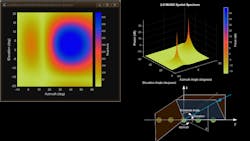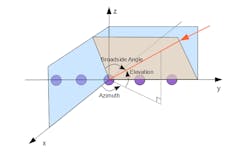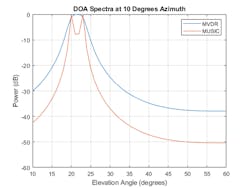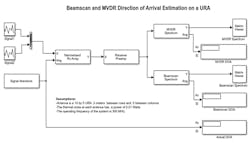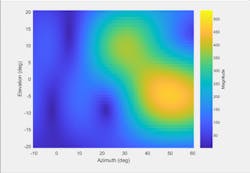Algorithms to Antenna: Developing Direction-of-Arrival Algorithms for Phased-Array Systems
In our last blog, we discussed some common types of beamforming algorithms along with a framework to develop and test your own beamformers. We now describe a related topic on spatial signal processing: direction-of-arrival (DOA) algorithms.
Similar to the beamforming concepts we previously described, DOA algorithms are enabled in phased-array applications by leveraging signal reception across multiple antenna elements to determine a signal’s azimuth and/or elevation. This type of algorithm is commonly used in radar, communications, and electronic-warfare (EW) applications to determine the direction of jamming sources or of the desired signal source.
To better understand DOA estimation, we look at several algorithms that trade off accuracy and computational performance. The first algorithm is beamscan, which is a technique that forms a conventional beam and scans it over directions of interest to obtain a spatial spectrum. The second algorithm—minimum variance distortionless response (MVDR)—is similar to beamscan, but uses an MVDR beam, which is one of the algorithms we discussed in the beamforming blog. Our third algorithm is multiple signal classification (MUSIC). It provides the highest-resolution DOA estimates of the three. For these DOA methods, the peaks of the output spatial spectrum indicate the DOAs of the received signals.
We start with an example to estimate angles using a uniform linear array (ULA) with 10 isotropic antennas spaced at 0.5 wavelength apart. Two narrowband signals are received by the array. The first signal arrives from 40 degrees in azimuth and the second signal arrives from −20 degrees in azimuth.
Because the ULA is symmetric around its axis, we can’t obtain both azimuth and elevation at the same time. Instead, we can estimate the broadside angle, which is measured from the broadside of the ULA. The relationship between these angles is illustrated in Figure 1. For the ULA examples in this blog, the elevation angle is zero and the azimuth angle is considered to be ±90 degrees; the broadside angle is the same as the azimuth angle.
The top plot in Figure 2 shows the results of a beamscan algorithm where two signal sources exist and are separated spatially (one at 40 degrees and one at −20 degrees). You can clearly see two peaks in the plot. These peaks translate to directions that match the ground truth in our example.
One of the weaknesses of the beamscan algorithm is the inability to resolve closely spaced sources. That is, when two signals arrive from directions separated by less than the beamwidth, beamscan doesn’t resolve the directions of the signals. To illustrate this limitation, we move the two received signals closer together (30 degrees and 40 degrees in azimuth). Now these signals exist within the beam and they can’t be resolved (bottom plot in Fig. 2). Note there’s only one peak that covers 30 and 40 degrees.
To resolve closely spaced signals, we can use either the MVDR or MUSIC algorithm introduced earlier.
As shown in Figure 3, the MVDR algorithm correctly estimates the DOAs that are unresolvable by beamscan (30 and 40 degrees). Figure 3 also shows the MUSIC algorithm that can be used to resolve these closely spaced signals. You can see from the overlay of the plots that the MUSIC algorithm provides higher resolution. This, of course, comes with a higher computational price.
It’s also worth noting that the MVDR and MUSIC algorithms are also more sensitive to sensor position errors. If sensor positions are inaccurate, these algorithms could actually produce a worse spatial spectrum than beamscan. If you further reduce the difference of two signal directions to a level that’s smaller than the beamwidth of an MVDR beam, the MVDR estimator will also fail. One other note: The amplitudes of MUSIC spectral peaks can’t be interpreted as the power of the sources.
These algorithms extend to other array geometries. Let’s switch to a 10-×-5 uniform rectangular array (URA) to estimate both azimuth and elevation angles. The element spacing is 0.3 meters between each row, and 0.5 meters between each column. We again use two signals. The first signal arrives from 40 degrees in azimuth and 45 degrees in elevation, while the second signal arrives from −20 degrees in azimuth and 20 degrees in elevation. Figure 4 shows the results for our three algorithms. Each of these algorithms is able to resolve the two signal sources.
To further compare the performance of the MVDR and MUSIC estimators, let’s consider sources located even closer together where the azimuth and elevation angles for the two sources are 10 degrees and 20 degrees (azimuth and elevation of source 1) and 10 degrees and 23 degrees (azimuth and elevation of source 2).
As illustrated in Figure 5, only the MUSIC algorithm correctly estimates the directions of arrival for the two sources because they fall in the same MVDR beam.
Comparing the Performance of DOA Algorithms
You can also use Simulink to set up a test harness and compare DOA algorithms directly. Let’s keep the last example with a 10-×-5 URA as the testbench. One signal source moves from 30 degrees azimuth, 10 degrees elevation to 50 degrees azimuth, −5 degrees elevation. The other signal source, with 3 dB less power, moves in the opposite direction. Rectangular arrays allow the DOA estimators to determine both the azimuth and elevation.
To test the corner cases expected to be seen in your application, you can add your own DOA algorithms with controlled inputs to the framework shown in Figure 6.
To start, the beamscan spectrum (Fig. 7) shows two wide peaks with different magnitudes.
When the sources are approximately 10 degrees apart, the peaks merge and the DOAs of the signals aren’t clearly distinguished, as shown in the top plot of Figure 8. The MVDR spectrum can still distinguish both peaks (Figure 8, bottom plot).
You can develop DOA algorithms that leverage your phased-array design. We discussed three common algorithms, each exhibiting strengths and weaknesses. In a future blog, we will look at several high-resolution DOA estimation techniques, including variants of the MUSIC, root-MUSIC, ESPRIT, and root-WSF algorithms.
To learn more about the topics covered in this blog, see the examples below or email me at [email protected]:
- Direction of Arrival Estimation with Beamscan, MVDR, and MUSIC (example): Learn how to use beamscan, MVDR, and MUSIC for DOA estimation.
- Direction of Arrival with Beamscan and MVDR with Simulink (example): Learn how to use beamscan and MVDR techniques for DOA estimation in Simulink.
- Direction of Arrival Algorithm Overview (Documentation): Learn how to model and test DOA algorithms.
See additional 5G, radar, and EW resources, including those referenced in previous blog posts.
About the Author
Rick Gentile
Product Manager, Phased Array System Toolbox and Signal Processing Toolbox
Rick Gentile is the product manager for Phased Array System Toolbox and Signal Processing Toolbox at MathWorks. Prior to joining MathWorks, Rick was a radar systems engineer at MITRE and MIT Lincoln Laboratory, where he worked on the development of several large radar systems. Rick also was a DSP applications engineer at Analog Devices, where he led embedded processor and system level architecture definitions for high performance signal processing systems used in a wide range of applications.
He received a BS in electrical and computer engineering from the University of Massachusetts, Amherst, and an MS in electrical and computer engineering from Northeastern University, where his focus areas of study included microwave engineering, communications, and signal processing.
